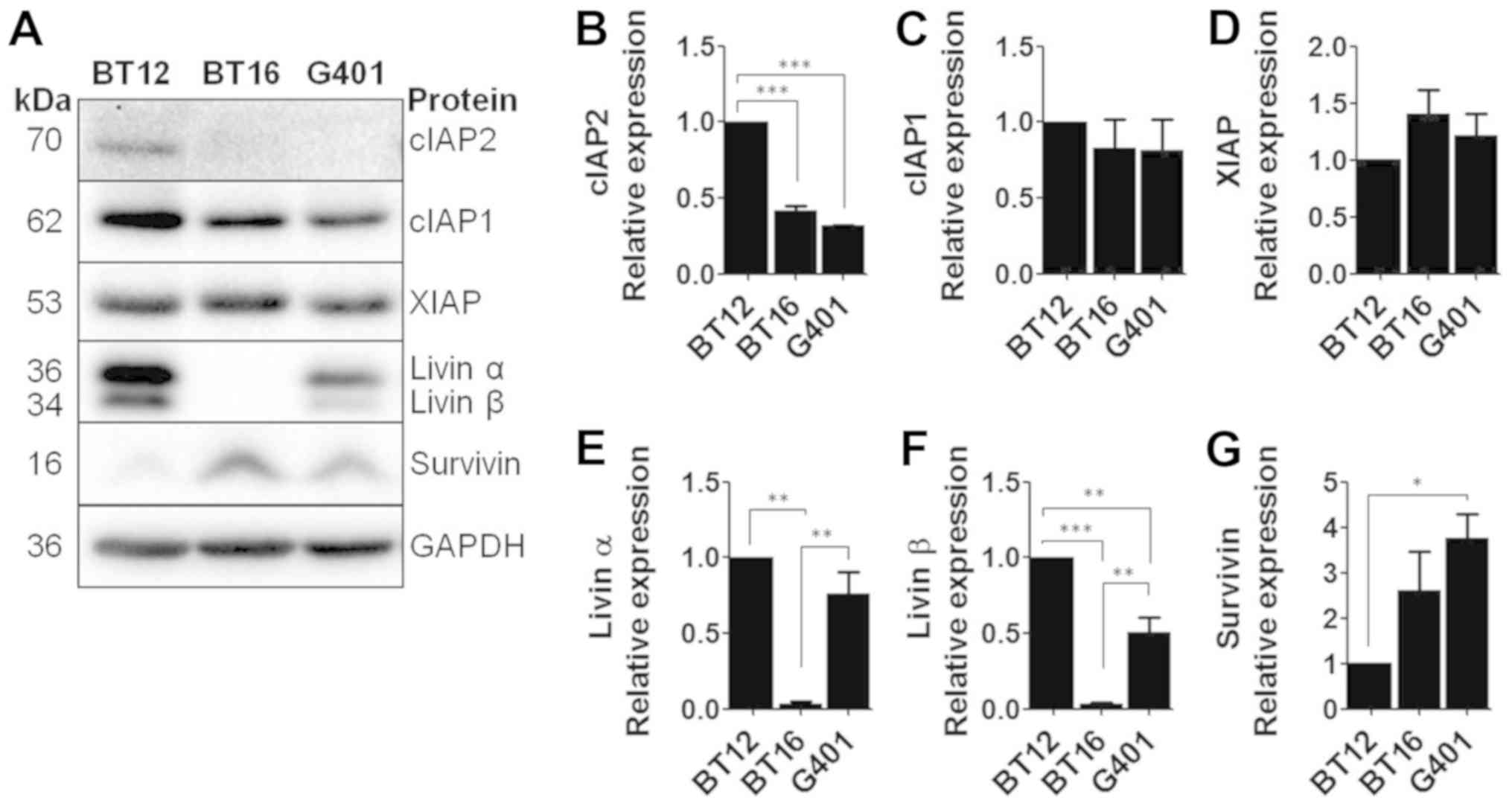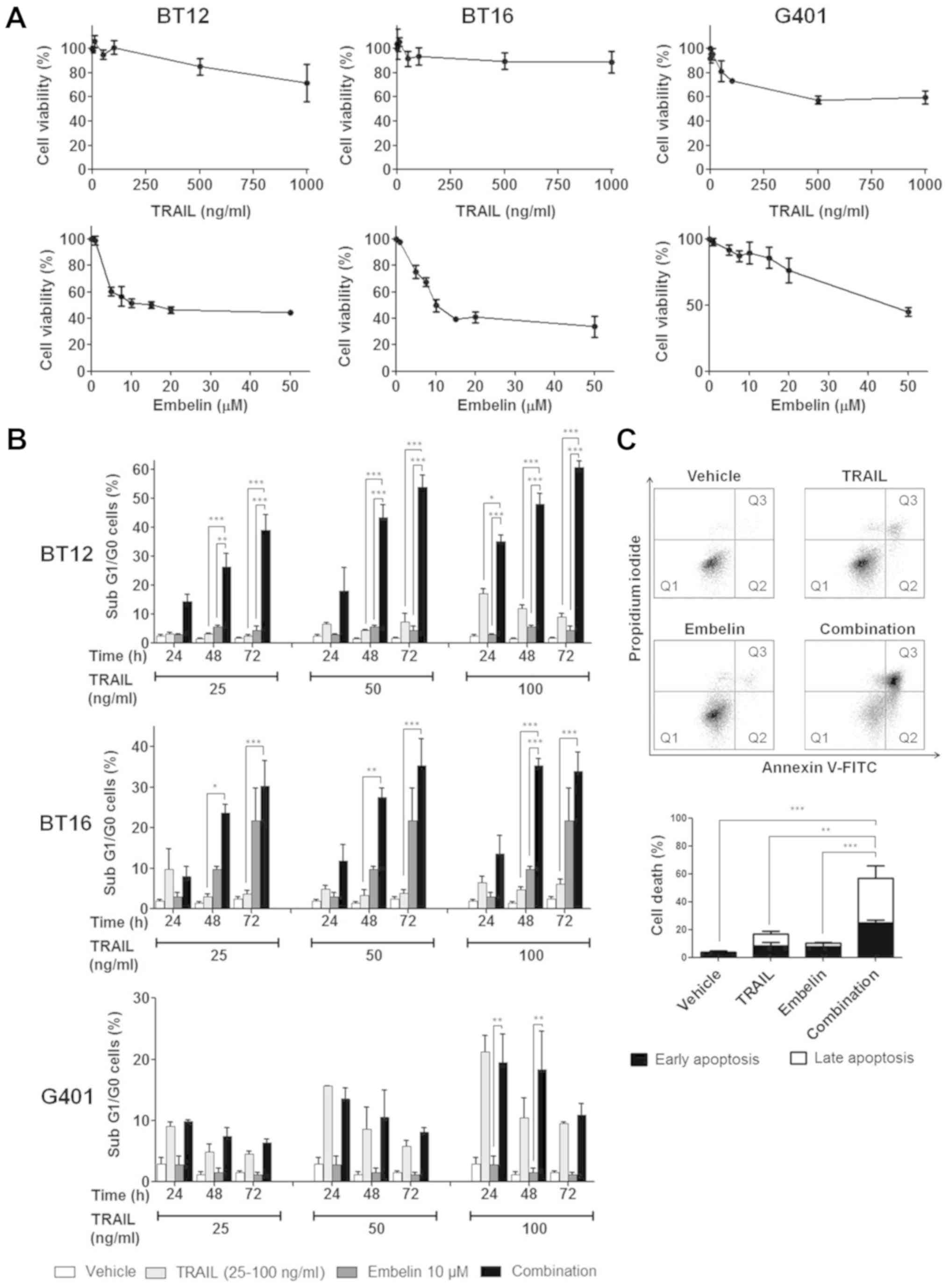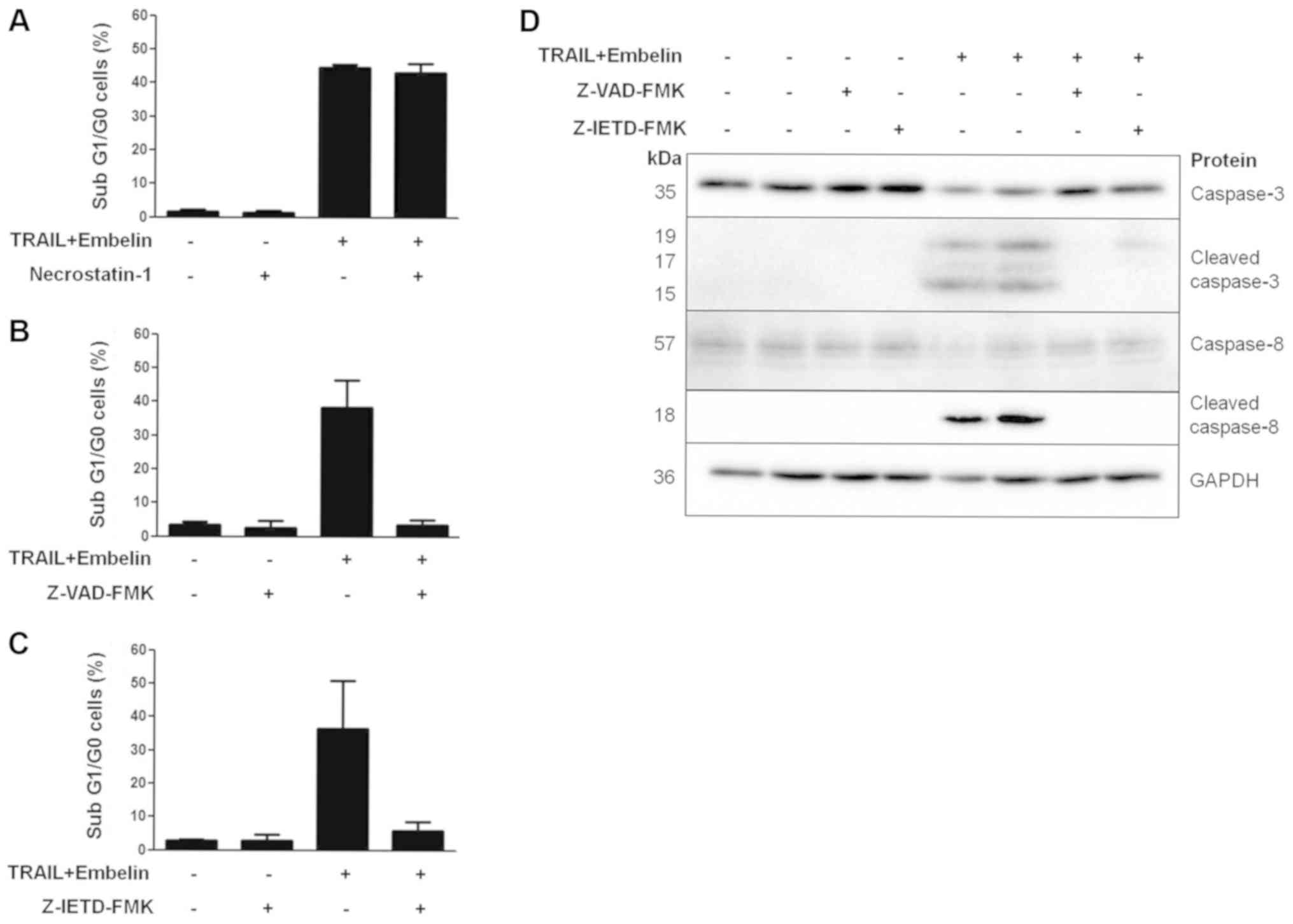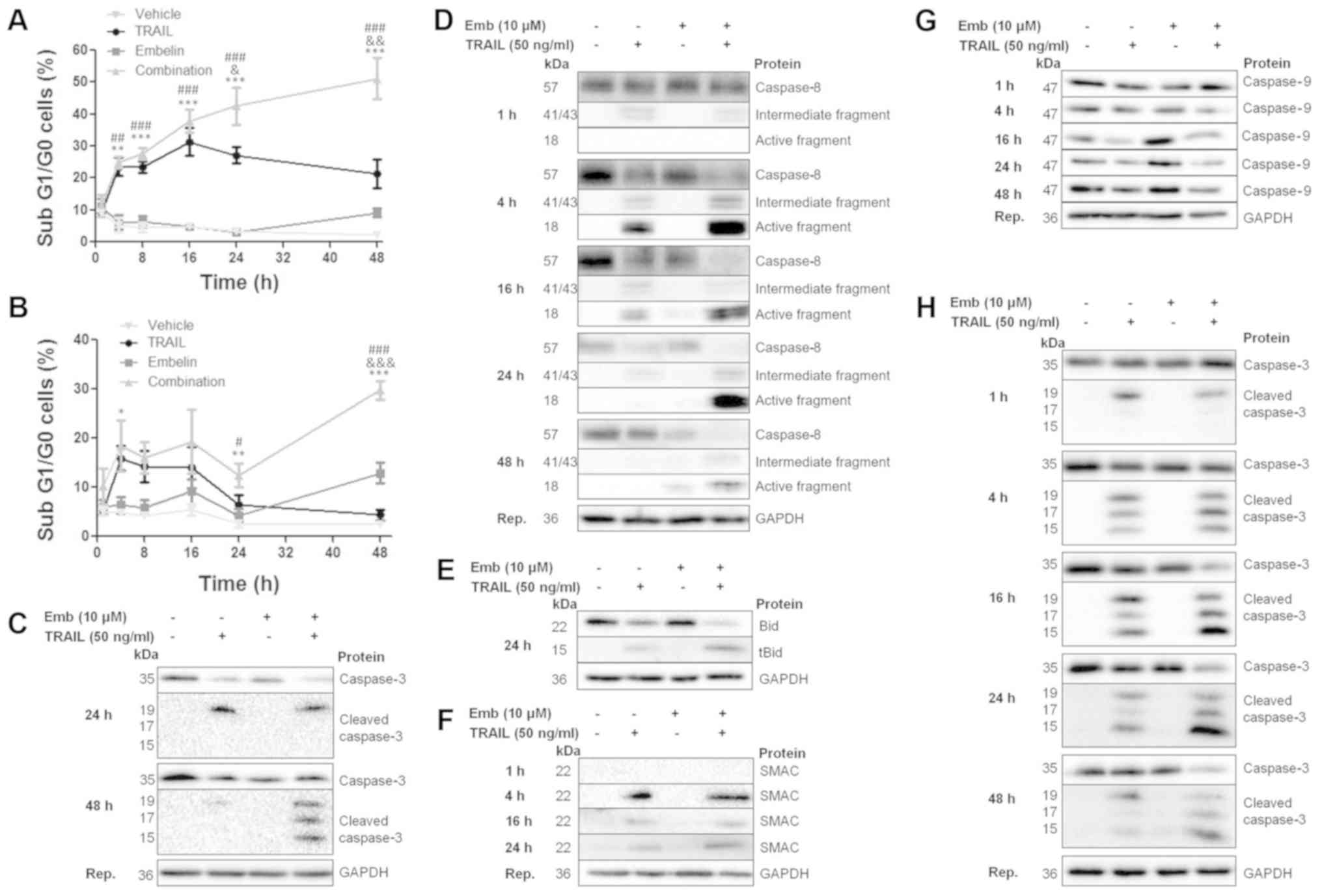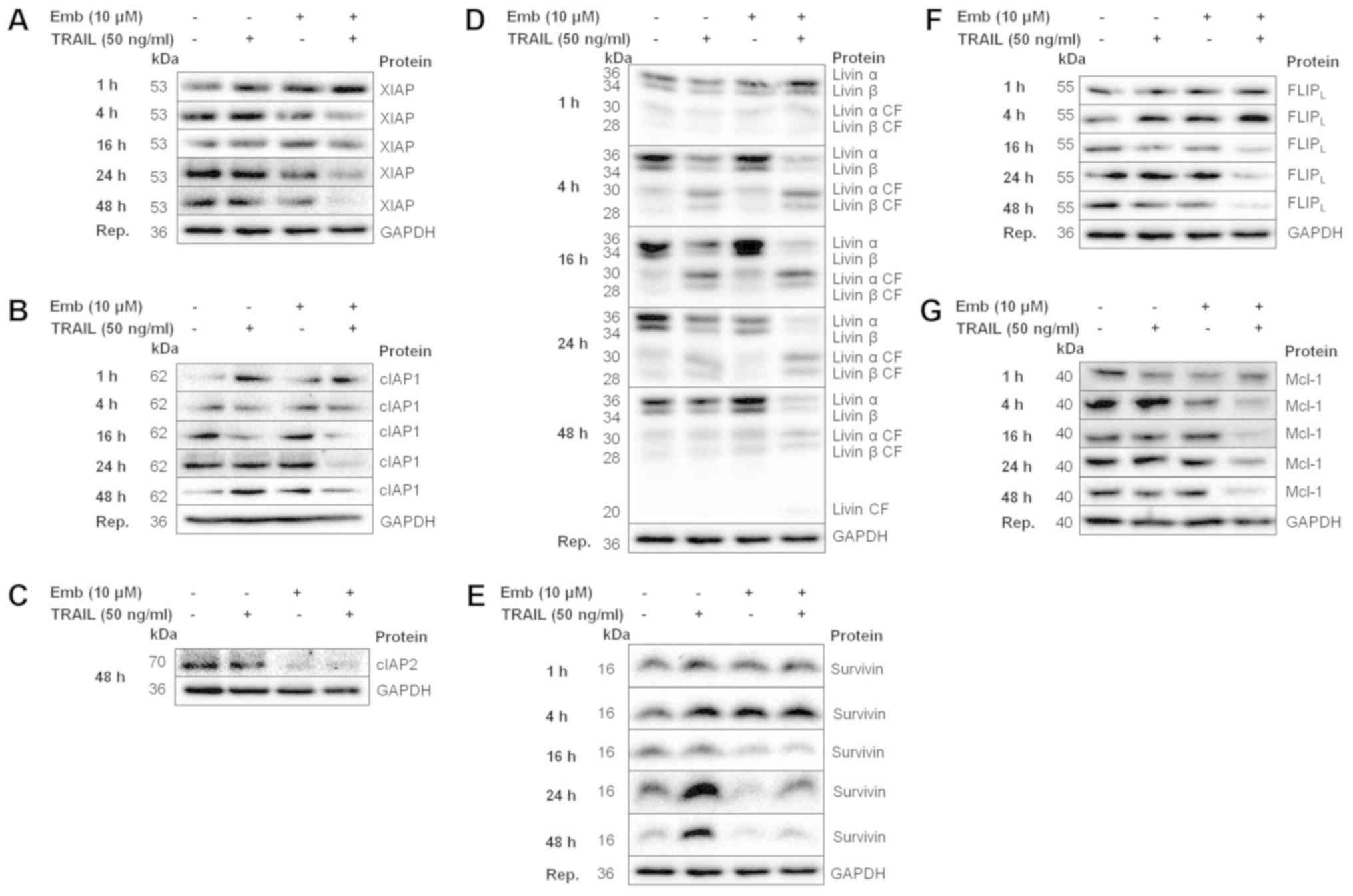|
1
|
Brennan B, Stiller C and Bourdeaut F:
Extracranial rhabdoid tumours: What we have learned so far and
future directions. Lancet Oncol. 14:e329–e336. 2013. View Article : Google Scholar : PubMed/NCBI
|
|
2
|
Geller JI, Roth JJ and Biegel JA: Biology
and Treatment of Rhabdoid Tumor. Crit Rev Oncog. 20:199–216. 2015.
View Article : Google Scholar : PubMed/NCBI
|
|
3
|
Biegel JA, Kalpana G, Knudsen ES, Packer
RJ, Roberts CW, Thiele CJ, Weissman B and Smith M: The role of INI1
and the SWI/SNF complex in the development of rhabdoid tumors:
Meeting summary from the workshop on childhood atypical
teratoid/rhabdoid tumors. Cancer Res. 62:323–328. 2002.PubMed/NCBI
|
|
4
|
Versteege I, Sévenet N, Lange J,
Rousseau-Merck MF, Ambros P, Handgretinger R, Aurias A and Delattre
O: Truncating mutations of hSNF5/INI1 in aggressive paediatric
cancer. Nature. 394:203–206. 1998. View
Article : Google Scholar : PubMed/NCBI
|
|
5
|
Hasselblatt M, Isken S, Linge A, Eikmeier
K, Jeibmann A, Oyen F, Nagel I, Richter J, Bartelheim K, Kordes U,
et al: High-resolution genomic analysis suggests the absence of
recurrent genomic alterations other than SMARCB1 aberrations in
atypical teratoid/rhabdoid tumors. Genes Chromosomes Cancer.
52:185–190. 2013. View Article : Google Scholar
|
|
6
|
Kieran MW, Roberts CW, Chi SN, Ligon KL,
Rich BE, Macconaill LE, Garraway LA and Biegel JA: Absence of
oncogenic canonical pathway mutations in aggressive pediatric
rhabdoid tumors. Pediatric Blood Cancer. 59:1155–1157. 2012.
View Article : Google Scholar : PubMed/NCBI
|
|
7
|
McKenna ES, Sansam CG, Cho YJ, Greulich H,
Evans JA, Thom CS, Moreau LA, Biegel JA, Pomeroy SL and Roberts CW:
Loss of the epigenetic tumor suppressor SNF5 leads to cancer
without genomic instability. Mol Cell Biol. 28:6223–6233. 2008.
View Article : Google Scholar : PubMed/NCBI
|
|
8
|
Lafay-Cousin L, Hawkins C, Carret AS,
Johnston D, Zelcer S, Wilson B, Jabado N, Scheinemann K, Eisenstat
D, Fryer C, et al: Central nervous system atypical teratoid
rhabdoid tumours: The Canadian Paediatric Brain Tumour Consortium
experience. Eur J Cancer. 48:353–359. 2012. View Article : Google Scholar
|
|
9
|
Tekautz TM, Fuller CE, Blaney S, Fouladi
M, Broniscer A, Merchant TE, Krasin M, Dalton J, Hale G, Kun LE, et
al: Atypical teratoid/rhabdoid tumors (ATRT): Improved survival in
children 3 years of age and older with radiation therapy and
high-dose alkylator-based chemotherapy. J Clin Oncol. 23:1491–1499.
2005. View Article : Google Scholar : PubMed/NCBI
|
|
10
|
Chi SN, Zimmerman MA, Yao X, Cohen KJ,
Burger P, Biegel JA, Rorke-Adams LB, Fisher MJ, Janss A, Mazewski
C, et al: Intensive multimodality treatment for children with newly
diagnosed CNS atypical teratoid rhabdoid tumor. J Clin Oncol.
27:385–389. 2009. View Article : Google Scholar :
|
|
11
|
Walczak H, Miller RE, Ariail K, Gliniak B,
Griffith TS, Kubin M, Chin W, Jones J, Woodward A, Le T, et al:
Tumoricidal activity of tumor necrosis factor-related
apoptosis-inducing ligand in vivo. Nat Med. 5:157–163. 1999.
View Article : Google Scholar : PubMed/NCBI
|
|
12
|
Walczak H: Death receptor-ligand systems
in cancer, cell death, and inflammation. Cold Spring Harb Perspect
Biol. 5:a0086982013. View Article : Google Scholar : PubMed/NCBI
|
|
13
|
Czabotar PE, Lessene G, Strasser A and
Adams JM: Control of apoptosis by the BCL-2 protein family:
Implications for physiology and therapy. Nat Rev Mol Cell Biol.
15:49–63. 2014. View
Article : Google Scholar
|
|
14
|
Ouchi K, Kuwahara Y, Iehara T, Miyachi M,
Katsumi Y, Tsuchiya K, Konishi E, Yanagisawa A and Hosoi H: A
NOXA/MCL-1 Imbalance Underlies Chemoresistance of Malignant
Rhabdoid Tumor Cells. J Cell Physiol. 231:1932–1940. 2016.
View Article : Google Scholar
|
|
15
|
Cai JH, Fu SM, Tu ZH, Deng LQ, Liang Z,
Chen XP, Gong XJ and Wan LH: Survivin gene functions and
relationships between expression and prognosis in patients with
nasopharyngeal carcinoma. Asian Pac J Cancer Prev. 16:2341–2345.
2015. View Article : Google Scholar : PubMed/NCBI
|
|
16
|
Chen W, Qiu L, Hou J, Zhang X, Ke X, Wang
Z, Zhou F, Yang S, Zhao Y, Leng Y, et al: Phase Ib Study of
Recombinant Circularly Permuted TRAIL (CPT) in Relapsed or
Refractory multiple Myeloma Patients. Blood. 120:18572012.
|
|
17
|
Hotte SJ, Hirte HW, Chen EX, Siu LL, Le
LH, Corey A, Iacobucci A, MacLean M, Lo L, Fox NL and Oza AM: A
phase 1 study of mapatumumab (fully human monoclonal antibody to
TRAIL-R1) in patients with advanced solid malignancies. Clin Cancer
Res. 14:3450–3455. 2008. View Article : Google Scholar : PubMed/NCBI
|
|
18
|
Pan Y, Xu R, Peach M, Huang CP,
Branstetter D, Novotny W, Herbst RS, Eckhardt SG and Holland PM:
Evaluation of pharmacodynamic biomarkers in a Phase 1a trial of
dulanermin (rhApo2L/TRAIL) in patients with advanced tumours. Br J
Cancer. 105:1830–1838. 2011. View Article : Google Scholar : PubMed/NCBI
|
|
19
|
Soria JC, Márk Z, Zatloukal P, Szima B,
Albert I, Juhász E, Pujol JL, Kozielski J, Baker N, Smethurst D, et
al: Randomized phase II study of dulanermin in combination with
paclitaxel, carboplatin, and bevacizumab in advanced non-small-cell
lung cancer. J Clin Oncol. 29:4442–4451. 2011. View Article : Google Scholar : PubMed/NCBI
|
|
20
|
Cho SB, Lee WS, Park YL, Kim N, Oh HH, Kim
MY, Oak CY, Chung CY, Park HC, Kim JS, et al: Livin is associated
with the invasive and oncogenic phenotypes of human hepatocellular
carcinoma cells. Hepatol Res. 45:448–457. 2015. View Article : Google Scholar
|
|
21
|
Dasgupta A, Alvarado CS, Xu Z and Findley
HW: Expression and functional role of inhibitor-of-apoptosis
protein livin (BIRC7) in neuroblastoma. Biochem Biophys Res Commun.
400:53–59. 2010. View Article : Google Scholar : PubMed/NCBI
|
|
22
|
Kempkensteffen C, Hinz S, Christoph F,
Köllermann J, Krause H, Schrader M, Schostak M, Miller K and
Weikert S: Expression parameters of the inhibitors of apoptosis
cIAP1 and cIAP2 in renal cell carcinomas and their prognostic
relevance. Int J Cancer. 120:1081–1086. 2007. View Article : Google Scholar
|
|
23
|
Kim DK, Alvarado CS, Abramowsky CR, Gu L,
Zhou M, Soe MM, Sullivan K, George B, Schemankewitz E and Findley
HW: Expression of inhibitor-of-apoptosis protein (IAP) livin by
neuroblastoma cells: correlation with prognostic factors and
outcome. Pediatr Dev Pathol. 8:621–629. 2005. View Article : Google Scholar : PubMed/NCBI
|
|
24
|
Mizutani Y, Nakanishi H, Li YN, Matsubara
H, Yamamoto K, Sato N, Shiraishi T, Nakamura T, Mikami K, Okihara
K, et al: Overexpression of XIAP expression in renal cell carcinoma
predicts a worse prognosis. Int J Oncol. 30:919–925.
2007.PubMed/NCBI
|
|
25
|
Ramp U, Krieg T, Caliskan E, Mahotka C,
Ebert T, Willers R, Gabbert HE and Gerharz CD: XIAP expression is
an independent prognostic marker in clear-cell renal carcinomas.
Hum Pathol. 35:1022–1028. 2004. View Article : Google Scholar : PubMed/NCBI
|
|
26
|
Shi YH, Ding WX, Zhou J, He JY, Xu Y,
Gambotto AA, Rabinowich H, Fan J and Yin XM: Expression of X-linked
inhibitor-of-apoptosis protein in hepatocellular carcinoma promotes
metastasis and tumor recurrence. Hepatology. 48:497–507. 2008.
View Article : Google Scholar : PubMed/NCBI
|
|
27
|
Tamm I, Kornblau SM, Segall H, Krajewski
S, Welsh K, Kitada S, Welsh K, Kitada S, Scudiero DA, Tudor G, Qui
YH, Monks A, et al: Expression and prognostic significance of
IAP-family genes in human cancers and myeloid leukemias. Clin
Cancer Res. 6:1796–1803. 2000.PubMed/NCBI
|
|
28
|
Tamm I, Richter S, Oltersdorf D, Creutzig
U, Harbott J, Scholz F, Karawajew L, Ludwig WD and Wuchter C: High
expression levels of x-linked inhibitor of apoptosis protein and
survivin correlate with poor overall survival in childhood de novo
acute myeloid leukemia. Clin Cancer Res. 10:3737–3744. 2004.
View Article : Google Scholar : PubMed/NCBI
|
|
29
|
Huang Y, Park YC, Rich RL, Segal D, Myszka
DG and Wu H: Structural basis of caspase inhibition by XIAP:
Differential roles of the linker versus the BIR domain. Cell.
104:781–790. 2001.PubMed/NCBI
|
|
30
|
Riedl SJ, Renatus M, Schwarzenbacher R,
Zhou Q, Sun C, Fesik SW, Liddington RC and Salvesen GS: Structural
basis for the inhibition of caspase-3 by XIAP. Cell. 104:791–800.
2001. View Article : Google Scholar : PubMed/NCBI
|
|
31
|
Scott FL, Denault JB, Riedl SJ, Shin H,
Renatus M and Salvesen GS: XIAP inhibits caspase-3 and -7 using two
binding sites: evolutionarily conserved mechanism of IAPs. EMBO J.
24:645–655. 2005. View Article : Google Scholar : PubMed/NCBI
|
|
32
|
Shiozaki EN, Chai J, Rigotti DJ, Riedl SJ,
Li P, Srinivasula SM, Alnemri ES, Fairman R and Shi Y: Mechanism of
XIAP-mediated inhibition of caspase-9. Mol Cell. 11:519–527. 2003.
View Article : Google Scholar : PubMed/NCBI
|
|
33
|
Srinivasula SM, Hegde R, Saleh A, Datta P,
Shiozaki E, Chai J, Lee RA, Robbins PD, Fernandes-Alnemri T, Shi Y,
et al: A conserved XIAP-interaction motif in caspase-9 and
Smac/DIABLO regulates caspase activity and apoptosis. Nature.
410:112–116. 2001. View Article : Google Scholar : PubMed/NCBI
|
|
34
|
Suzuki Y, Nakabayashi Y, Nakata K, Reed JC
and Takahashi R: X-linked inhibitor of apoptosis protein (XIAP)
inhibits caspase-3 and -7 in distinct modes. J Biol Chem.
276:27058–27063. 2001. View Article : Google Scholar : PubMed/NCBI
|
|
35
|
Deveraux QL, Roy N, Stennicke HR, Van
Arsdale T, Zhou Q, Srinivasula SM, Srinivasula SM, Alnemri ES,
Salvesen GS and Reed JC: IAPs block apoptotic events induced by
caspase-8 and cytochrome c by direct inhibition of distinct
caspases. EMBO J. 17:2215–2223. 1998. View Article : Google Scholar : PubMed/NCBI
|
|
36
|
Deveraux QL, Takahashi R, Salvesen GS and
Reed JC: X-linked IAP is a direct inhibitor of cell-death
proteases. Nature. 388:300–304. 1997. View
Article : Google Scholar : PubMed/NCBI
|
|
37
|
Nikolovska-Coleska Z, Xu L, Hu Z, Tomita
Y, Li P, Roller PP, Wang R, Fang X, Guo R, Zhang M, et al:
Discovery of embelin as a cell-permeable, small-molecular weight
inhibitor of XIAP through structure-based computational screening
of a traditional herbal medicine three-dimensional structure
database. J Med Chem. 47:2430–2440. 2004. View Article : Google Scholar : PubMed/NCBI
|
|
38
|
Hu R, Zhu K, Li Y, Yao K, Zhang R, Wang H,
Yang W and Liu Z: Embelin induces apoptosis through down-regulation
of XIAP in human leukemia cells. Med Oncol. 28:1584–1588. 2011.
View Article : Google Scholar
|
|
39
|
Park N, Baek HS and Chun YJ:
Embelin-Induced Apoptosis of Human Prostate Cancer Cells Is
Mediated through Modulation of Akt and β-Catenin Signaling. PloS
One. 10:e01347602015. View Article : Google Scholar
|
|
40
|
Shah P, Djisam R, Damulira H, Aganze A and
Danquah M: Embelin inhibits proliferation, induces apoptosis and
alters gene expression profiles in breast cancer cells. Pharmacol
Rep. 68:638–644. 2016. View Article : Google Scholar : PubMed/NCBI
|
|
41
|
Sumalatha KR, Abiramasundari G, Chetan GK,
Divya T, Sudhandiran G and Sreepriya M: XIAP inhibitor and
antiestrogen embelin abrogates metastasis and augments apoptosis in
estrogen receptor positive human breast adenocarcinoma cell line
MCF-7. Mol Biol Rep. 41:935–946. 2014. View Article : Google Scholar : PubMed/NCBI
|
|
42
|
Wang A, Zhang B, Zhang J and Wu W and Wu
W: Embelin-induced brain glioma cell apoptosis and cell cycle
arrest via the mitochondrial pathway. Oncol Rep. 29:2473–2478.
2013. View Article : Google Scholar : PubMed/NCBI
|
|
43
|
Wang DG, Sun YB, Ye F, Li W, Kharbuja P,
Gao L, Zhang DY and Suo J: Anti-tumor activity of the X-linked
inhibitor of apoptosis (XIAP) inhibitor embelin in gastric cancer
cells. Mol Cell Biochem. 386:143–152. 2014. View Article : Google Scholar
|
|
44
|
Xu CL, Zheng B, Pei JH, Shen SJ and Wang
JZ: Embelin induces apoptosis of human gastric carcinoma through
inhibition of p38 MAPK and NF-κB signaling pathways. Mol Med Rep.
14:307–312. 2016. View Article : Google Scholar : PubMed/NCBI
|
|
45
|
Cheng YJ, Jiang HS, Hsu SL, Lin LC, Wu CL,
Ghanta VK and Hsueh CM: XIAP-mediated protection of H460 lung
cancer cells against cisplatin. Eur J Pharmacol. 627:75–84. 2010.
View Article : Google Scholar
|
|
46
|
Dai Y, Desano J, Qu Y, Tang W, Meng Y,
Lawrence TS and Xu L: Natural IAP inhibitor Embelin enhances
therapeutic efficacy of ionizing radiation in prostate cancer. Am J
Cancer Res. 1:128–143. 2011.PubMed/NCBI
|
|
47
|
Allensworth JL, Aird KM, Aldrich AJ,
Batinic-Haberle I and Devi GR: XIAP inhibition and generation of
reactive oxygen species enhances TRAIL sensitivity in inflammatory
breast cancer cells. Mol Cancer Ther. 11:1518–1527. 2012.
View Article : Google Scholar : PubMed/NCBI
|
|
48
|
Hu R, Yang Y, Liu Z, Jiang H, Zhu K, Li J
and Xu W: The XIAP inhibitor Embelin enhances TRAIL-induced
apoptosis in human leukemia cells by DR4 and DR5 upregulation.
Tumour Biol. 36:769–777. 2015. View Article : Google Scholar
|
|
49
|
Jiang L, Hao JL, Jin ML, Zhang YG and Wei
P: Effect of Embelin on TRAIL receptor 2 mAb-induced apoptosis of
TRAIL-resistant A549 non-small cell lung cancer cells. Asian Pac J
Cancer Prev. 14:6115–6120. 2013. View Article : Google Scholar : PubMed/NCBI
|
|
50
|
Mori T, Doi R, Kida A, Nagai K, Kami K,
Ito D, Toyoda E, Kawaguchi Y and Uemoto S: Effect of the XIAP
inhibitor Embelin on TRAIL-induced apoptosis of pancreatic cancer
cells. J Surg Res. 142:281–286. 2007. View Article : Google Scholar : PubMed/NCBI
|
|
51
|
Qian H, Chen Y, Huang T, Liu T, Li X,
Jiang G, Zhang W, Cheng S and Li P: Combined application of Embelin
and tumor necrosis factor-related apoptosis-inducing ligand
inhibits proliferation and invasion in osteosarcoma cells via
caspase-induced apoptosis. Oncol Lett. 15:6931–6940.
2018.PubMed/NCBI
|
|
52
|
Siegelin MD, Gaiser T and Siegelin Y: The
XIAP inhibitor Embelin enhances TRAIL-mediated apoptosis in
malignant glioma cells by down-regulation of the short isoform of
FLIP. Neurochem Int. 55:423–430. 2009. View Article : Google Scholar : PubMed/NCBI
|
|
53
|
Yang S, Li SS, Yang XM, Yin DH and Wang L:
Embelin prevents LMP1-induced TRAIL resistance via inhibition of
XIAP in nasopharyngeal carcinoma cells. Oncol Lett. 11:4167–4176.
2016. View Article : Google Scholar : PubMed/NCBI
|
|
54
|
Yang T, Lan J, Huang Q, Chen X, Sun X, Liu
X, Yang P, Jin T, Wang S and Mou X: Embelin sensitizes acute
myeloid leukemia cells to TRAIL through XIAP inhibition and NF-κB
inactivation. Cell Biochem Biophys. 71:291–297. 2015. View Article : Google Scholar
|
|
55
|
Yoshida S, Narita T, Koshida S, Ohta S and
Takeuchi Y: TRAIL/Apo2L ligands induce apoptosis in malignant
rhabdoid tumor cell lines. Pediatr Res. 54:709–717. 2003.
View Article : Google Scholar : PubMed/NCBI
|
|
56
|
Du C, Fang M, Li Y, Li L and Wang X: Smac,
a mitochondrial protein that promotes cytochrome c-dependent
caspase activation by eliminating IAP inhibition. Cell. 102:33–42.
2000. View Article : Google Scholar : PubMed/NCBI
|
|
57
|
Ekert PG, Silke J, Hawkins CJ, Verhagen AM
and Vaux DL: DIABLO promotes apoptosis by removing MIHA/XIAP from
processed caspase 9. J Cell Biol. 152:483–490. 2001. View Article : Google Scholar : PubMed/NCBI
|
|
58
|
Houghton PJ, Kang MH, Reynolds CP, Morton
CL, Kolb EA, Gorlick R, Keir ST, Carol H, Lock R, Maris JM, et al:
Initial testing (stage 1) of LCL161, a SMAC mimetic, by the
Pediatric Preclinical Testing Program. Pediatr Blood Cancer.
58:636–639. 2012. View Article : Google Scholar :
|
|
59
|
Langemann D, Trochimiuk M, Appl B,
Hundsdoerfer P, Reinshagen K and Eschenburg G: Sensitization of
neuroblastoma for vincristine-induced apoptosis by Smac mimetic
LCL161 is attended by G2 cell cycle arrest but is independent of
NFκB, RIP1 and TNF-α. Oncotarget. 8:87763–87772. 2017. View Article : Google Scholar : PubMed/NCBI
|
|
60
|
Najem S, Langemann D, Appl B, Trochimiuk
M, Hundsdoerfer P, Reinshagen K and Eschenburg G: Smac mimetic
LCL161 supports neuroblastoma chemotherapy in a drug
class-dependent manner and synergistically interacts with ALK
inhibitor TAE684 in cells with ALK mutation F1174L. Oncotarget.
7:72634–72653. 2016. View Article : Google Scholar : PubMed/NCBI
|
|
61
|
Qin Q, Zuo Y, Yang X, Lu J, Zhan L, Xu L,
Zhang C, Zhu H, Liu J, Liu Z, et al: Smac mimetic compound LCL161
sensitizes esophageal carcinoma cells to radiotherapy by inhibiting
the expression of inhibitor of apoptosis protein. Tumour Biol.
35:2565–2574. 2014. View Article : Google Scholar
|
|
62
|
Yang C, Wang H, Zhang B, Chen Y, Zhang Y,
Sun X, Xiao G, Nan K, Ren H and Qin S: LCL161 increases
paclitaxel-induced apoptosis by degrading cIAP1 and cIAP2 in NSCLC.
J Exp Clin Cancer Res. 35:1582016. View Article : Google Scholar : PubMed/NCBI
|
|
63
|
Clemens MR, Gladkov OA, Gartner E,
Vladimirov V, Crown J, Steinberg J, Jie F and Keating A: Phase II,
multicenter, open-label, randomized study of YM155 plus docetaxel
as first-line treatment in patients with HER2-negative metastatic
breast cancer. Breast Cancer Res Treat. 149:171–179. 2015.
View Article : Google Scholar :
|
|
64
|
Kelly RJ, Thomas A, Rajan A, Chun G,
Lopez-Chavez A, Szabo E, Spencer S, Carter CA, Guha U, Khozin S, et
al: A phase I/II study of sepantronium bromide (YM155, survivin
suppressor) with paclitaxel and carboplatin in patients with
advanced non-small-cell lung cancer. Ann Oncol. 24:2601–2606. 2013.
View Article : Google Scholar : PubMed/NCBI
|
|
65
|
Singh B, Guru SK, Sharma R, Bharate SS,
Khan IA, Bhushan S, Bharate SB and Vishwakarma RA: Synthesis and
anti-proliferative activities of new derivatives of embelin. Bioorg
Med Chem Lett. 24:4865–4870. 2014. View Article : Google Scholar : PubMed/NCBI
|
|
66
|
Hartwig T, Montinaro A, von Karstedt S,
Sevko A, Surinova S, Chakravarthy A, Taraborrelli L, Draber P,
Lafont E, Arce Vargas F, et al: The TRAIL-Induced Cancer Secretome
Promotes a Tumor-Supportive Immune Microenvironment via CCR2. Mol
Cell. 65:730–742.e5. 2017. View Article : Google Scholar : PubMed/NCBI
|
|
67
|
Henry CM and Martin SJ: Caspase-8 Acts in
a Non-enzymatic Role as a Scaffold for Assembly of a
Pro-inflammatory 'FADDosome' Complex upon TRAIL Stimulation. Mol
Cell. 65:715–729.e5. 2017. View Article : Google Scholar
|
|
68
|
Lafont E, Kantari-Mimoun C, Draber P, De
Miguel D, Hartwig T, Reichert M, Kupka S, Shimizu Y, Taraborrelli
L, Spit M, et al: The linear ubiquitin chain assembly complex
regulates TRAIL-induced gene activation and cell death. EMBO J.
36:1147–1166. 2017. View Article : Google Scholar : PubMed/NCBI
|
|
69
|
Varfolomeev E, Maecker H, Sharp D,
Lawrence D, Renz M, Vucic D and Ashkenazi A: Molecular determinants
of kinase pathway activation by Apo2 ligand/tumor necrosis
factor-related apoptosis-inducing ligand. J Biol Chem.
280:40599–40608. 2005. View Article : Google Scholar : PubMed/NCBI
|
|
70
|
von Karstedt S, Conti A, Nobis M,
Montinaro A, Hartwig T, Lemke J, Legler K, Annewanter F, Campbell
AD, Taraborrelli L, et al: Cancer cell-autonomous TRAIL-R signaling
promotes KRAS-driven cancer progression, invasion, and metastasis.
Cancer Cell. 27:561–573. 2015. View Article : Google Scholar : PubMed/NCBI
|
|
71
|
Flusberg DA, Roux J, Spencer SL and Sorger
PK: Cells surviving fractional killing by TRAIL exhibit transient
but sustainable resistance and inflammatory phenotypes. Mol Biol
Cell. 24:2186–2200. 2013. View Article : Google Scholar : PubMed/NCBI
|
|
72
|
Hörnle M, Peters N, Thayaparasingham B,
Vörsmann H, Kashkar H and Kulms D: Caspase-3 cleaves XIAP in a
positive feedback loop to sensitize melanoma cells to TRAIL-induced
apoptosis. Oncogene. 30:575–587. 2011. View Article : Google Scholar
|
|
73
|
Thayaparasingham B, Kunz A, Peters N and
Kulms D: Sensitization of melanoma cells to TRAIL by UVB-induced
and NF-kappaB-mediated downregulation of xIAP. Oncogene.
28:345–362. 2009. View Article : Google Scholar
|
|
74
|
Ma L, Huang Y, Song Z, Feng S, Tian X, Du
W, Qiu X, Heese K and Wu M: Livin promotes Smac/DIABLO degradation
by ubiquitin-proteasome pathway. Cell Death Differ. 13:2079–2088.
2006. View Article : Google Scholar : PubMed/NCBI
|
|
75
|
Abd-Elrahman I, Hershko K, Neuman T,
Nachmias B, Perlman R and Ben-Yehuda D: The inhibitor of apoptosis
protein Livin (ML-IAP) plays a dual role in tumorigenicity. Cancer
Res. 69:5475–5480. 2009. View Article : Google Scholar : PubMed/NCBI
|
|
76
|
Nachmias B, Ashhab Y, Bucholtz V, Drize O,
Kadouri L, Lotem M, Peretz T, Mandelboim O and Ben-Yehuda D:
Caspase-mediated cleavage converts Livin from an antiapoptotic to a
proapoptotic factor: Implications for drug-resistant melanoma.
Cancer Res. 63:6340–6349. 2003.PubMed/NCBI
|















